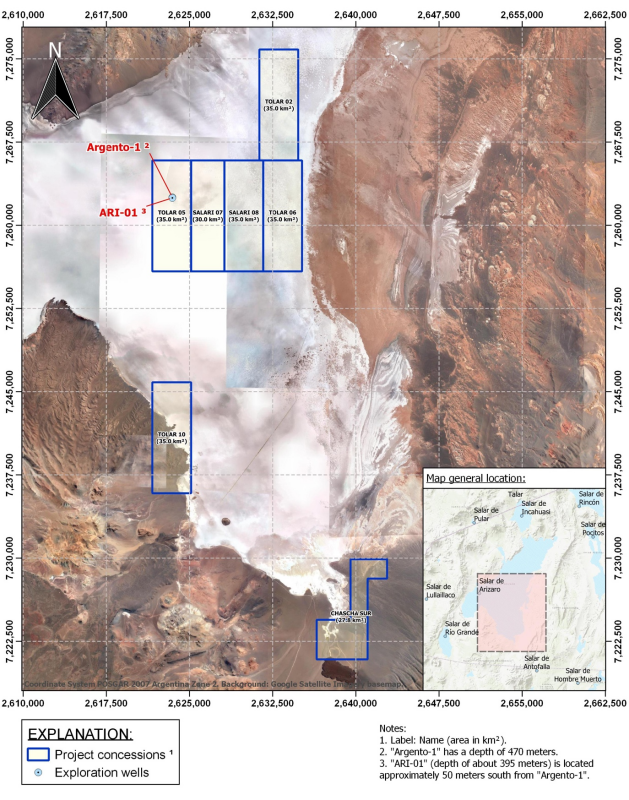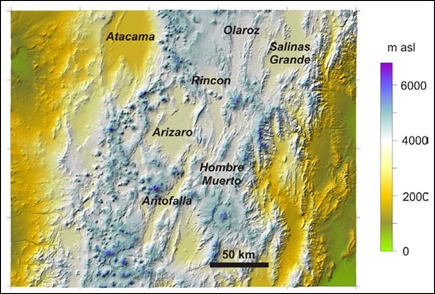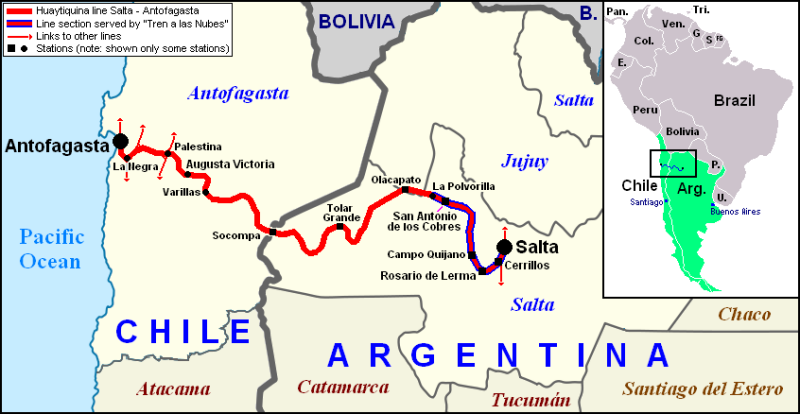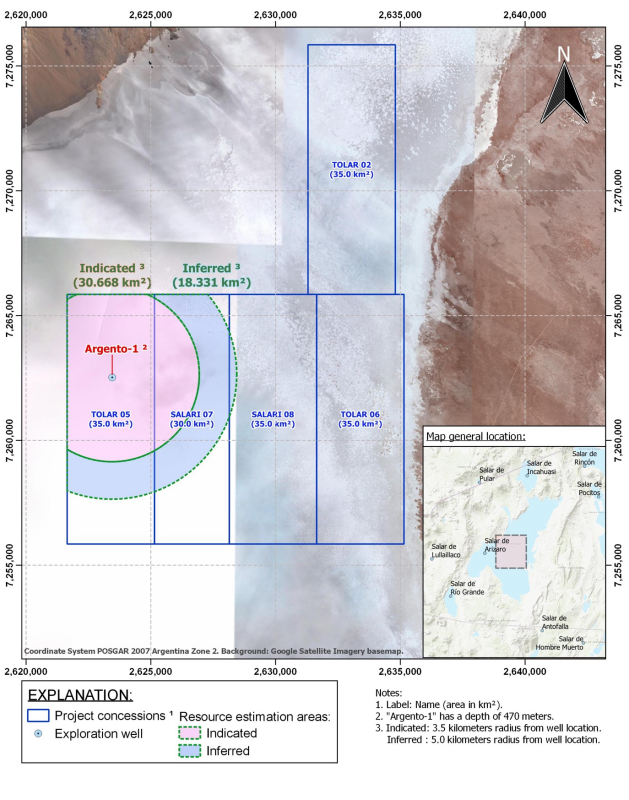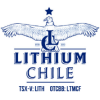


Calgary, Alberta, February 8, 2022 – TheNewswire - Lithium Chile Inc. (TSXV:LITH) (OTC:LTMCF) (“Lithium Chile” or the “Company”) is pleased to report an initial lithium (“Li”) resource statement for its first test well in the Arizaro de Salar project. The NI 43-101 resource statement, detailed in Table 3.2 below, includes 1,420,000 tonnes of lithium carbonate (“Li2CO3”) equivalent in the Indicated and Inferred Resource categories.
Steve Cochrane, President and CEO of Lithium Chile, commented on the maiden resource for the Arizaro de Salar Project: “We are very excited to see a strong NI 43-101 resource estimate from our hydrogeological consultants. The Company has adopted an aggressive plan which includes a follow up phase 2 drilling program consisting of three, 500-metre-deep exploration holes aimed at expanding the lithium resource and improving the grade on the Arizaro property.”
Highlights from the Test Well
-
1,420,000 tonne, NI 43-101 compliant lithium carbonate equivalent resource;
-
Grades as high as 555 mg/litre, higher than average in the Salar;
-
21.94 litres per second average pumping rate, higher than average in the Salar;
-
Resource estimate from only 29% of the main concession block leaving abundant area for resource expansion;
-
NI 43-101 report recommends a second program of US $2 million and three holes aimed at:
Summary of the Salar de Arizaro Project:
-
The Project is located in the Arizaro Salar located in the Salta province of northwest Argentina - about 170 kilometers (km) from Salta. Salta is considered the best investment district in the Lithium Triangle according to the Fraser Institute.
-
Lithium Chile controls 23,300 ha of legal concessions located mainly in the central part of the salar which is strategically located close to the best water supply area.
-
Arizaro is the largest salar in Argentina and one of the most important in all of Puna Region - becoming an important new mining area because of the success of recent lithium projects.
-
The railway between Salta and the Antofagasta port passes over the Arizaro Salar very close to Lithium Chile’s concessions.
-
An initial resource estimate just in a limited portion of concessions totaled 1,420,000 tonnes of lithium carbonate equivalent consisting of 895,000 tonnes of Indicated Resources together with 535,000 tonnes of Inferredlithium carbonate equivalent. The resource report suggests that resources in the measured category will be established by additional drilling which will also increase the indicated and inferred volumes appreciably.
-
Pump testing included step-discharge and constant discharge tests which achieved an average pumping rate of 21.94 litres per second and transmissivity of 100 m/d which is considered very good in comparison with other salars in the region.
-
Several brine samples were collected from the initial test well, known as Argento-1, During the drilling of the well, during testing of the overall aquifer, and subsequently over specific intervals in the reservoir using a Hydra-sleeve and inflatable packers, permitted Lithium Chile to obtain depth-specific samples.
-
Hydra-sleeve samples yielded values up to 446 mg/l of Li. Using the inflatable packer system, lithium samples returned values up to 555 mg/ls.
-
Based on potential dilutions and grade shown during pump testing, an average of 298 mg/lt of Li was used in resources calculation.
-
Lithium Chile plans on a follow up phase 2 program of three 500 meter deep exploration holes aimed at expanding the lithium resource on the Arizaro property. The program is budgeted at $2,000,000 US and is scheduled to commence immediately.
-
Lithium Chile is conducting operations through its Argentinian subsidiary Argentum Lithium. Argentum Lithium has fostered a good relationship with local communities within the region through its “Shared Value Philosophy”. It has strong relationships with Tolar Grande, the closest town which is the last inhabited point in the province on the frontier with Chile.
Background
The Project is located in the Arizaro “salar” in the Salta province, in northwest Argentina, about 170 kilometers (km) from Salta, and approximately 38 kilometers (km) southwest of the town of Tolar Grande. The Project is in the Argentinean Puna, at an elevation of approximately 3,475 meters above mean sea level (amsl).
The Arizaro Project currently consists of seven Exploration and Exploitation Concessions (minas) and Exploration Permits (cateos) totaling 23,300 hectares.
Main infrastructure in the zone consist in an electrical power line (375 kilovolts (KV)), a natural gas pipeline (Gasoducto de la Puna) between Salta (Argentina) and Mejillones (Chile) and a railway between Antofagasta (Chile) and Salta (Argentina).
Salars near the Project area includes: Hombre Muerto, Antofalla, Ratones, Pocitos, Centenario, and Diablillos and Atacama. The Arizaro Salar occupies one of these endorheic (internally drained) basins.
Salar de Arizaro is a mature salar, and the largest salars in the Argentinean altiplano. A thick halite core exists in the basin. Basin margins are interpreted to be fault controlled.
Drilling activities for exploration well Argento-1 started on September 5, 2021, reaching a depth of 470 meters below land surface (bls) on November 28, 2021. Pumping tests were conducted at exploration well Argento-1 in December 2021, and included step-discharge and constant discharge tests.
The ranges of the specific yield values obtained from the BMR survey are reasonable and consistent with values for similar units defined in other altiplanic salars for different projects.
Samples were taken both during drilling, during the pumping test, and after well construction. Pumped samples obtained at variable depths during drilling using a downhole sampling pump,
-
Brine samples obtained during and at the end of the pumping test in exploration well Argento-1,
-
Hydrasleeve samples obtained at specific depths after the well was cased, and
-
Packer samples obtained after the wells was cased.
Although freshwater studies have yet to be conducted, Lithium Chile has a concession (ChasCha Sur) on the edge of the basin in the southeast part of the salar that is adjacent to a known area of fresh water. Based on the initial results of exploration to date, additional exploration activities are justified to better characterize the extent of the observed brine aquifer – especially the clastic unit underlying the massive halite. Additional drilling and testing will allow for expansion of the estimated lithium resource and will support estimation of a reserve in the future.
Figure 2‑1. Location Map of the Project Concession Areas
Figure 2‑2. Digital Elevation Model of the Puna Showing Several Salars
Figure 2‑3. Railroad Line from Mejillones to Salta
Table 2‑1. Summary of Lithologic Descriptions for Drill Cuttings Samples
|
From |
To |
Summary Log |
| 0 |
304 |
Crystalline halite |
|
304 |
364 |
Crystalline halite with some sand interbeds |
|
364 |
408 |
Fine sand with volcaniclastics and interbedded with halite |
|
408 |
470 |
Fine brown sand |
Pumping tests included step-discharge and constant discharge tests. Pumping test equipment was provided by drilling and testing contractor Andina Perforaciones, a local drilling contractor based in Salta, Argentina.
Table 2‑2. Summary of the Step-Discharge Test at Exploration Well Argento-1
|
Well Identifier |
Test Date |
Step |
Average Pumping Rate (L/s)1 |
Maximum Drawdown (meters) |
Specific Capacity (L/s/m)2 |
|
Argento-1 |
22/12/2021 |
1 |
5.6 |
6.54 |
0.86 |
|
2 |
10.6 |
11.38 |
0.93 |
||
|
3 |
22.7 |
26.54 |
0.86 |
1 L/s = liters per second
2 L/s/m = liters per second per meter of drawdown
Specific capacity of a well is computed by dividing the average pumping rate by the maximum water level drawdown at that rate and is expressed as liters per second per meter of drawdown (L/s/m).
Table 2‑3. Pumping test summary for exploration well Argento-1
|
Well Identifier |
Date Pumping Started |
Pumping / Recovery Duration (hours) |
Pre-Pumping Water Level (meters, bls)1 |
Average Pumping
Rate |
Drawdown After 17 Hours of Pumping (meters) |
Residual Drawdown After 1.09 Hours Of Recovery (meters) |
Specific Capacity (L/s/m)3 |
|
Argento-1 |
20-12-2021 |
17.40 / 1.09 |
4.07 |
21.94 |
29.96 |
3.78 |
0.73 |
1 meters, bls = meters below land surface
2 L/s = liters per second
3 L/s/m = liters per second per meter of drawdown
Calculated transmissivities for both the drawdown and recovery periods agree.
A summary of computed aquifer parameters is given in Table 2 -4 showing pumping rates world class for salars in region
Table 2‑4. Summary of Computed Aquifer Parameters at Well Argento-1
|
Pumped Well Identifier |
Average
Pumping Rate |
Cooper-Jacob (1946) Drawdown Method
Transmissivity |
Theis (1935) Recovery Method Transmissivity (m2d)3 |
|
Argento-1 |
21.94 |
100 |
100 |
1 Liters per second
2 Meters
3 Square meters per day
According to a more detailed evaluation of specific yield ranges five Zones are being defined by M&A, as well as slightly changing the depths for the unit breaks.
These following specific yield values were computed for the new units as defined by M&A solely based on the BMR results.
-
Zone 1 (Land surface to 12m) Sy values ranges from 15-23%; average_18%
-
Zone 2 (12m to 320m) Sy values ranges from 3-7%; average 3%
-
Zone 3 (320m to 380m) Sy values ranges from 6-12%; average 6%
-
Zone 4 (380m to 400m) Sy values ranges from 15-22%; average 18%
-
Zone 5 (400m to 443m) Sy values ranges from 7-13%; average 9%
Based on the results, the lower clastic unit below a depth of 304 meters is the most favorable unit for production pumping.
Lithium Chile has collected and received laboratory results for composite brine samples collected from well Argento-1 obtained during the drilling of the well, during aquifer testing, after testing using a sampling pump, and using Hydrasleeve depth-specific samples and inflatable packers obtained after the construction and testing of the well was complete.
Table 2‑5. Summary of Laboratory Chemical Results for Brine Samples Obtained
During Drilling at Well Argento-1
|
SAMPLE ID |
Date |
Depth |
Li |
Mg |
K |
B |
|
|
1 |
11/9/2021 |
<10 |
102 |
786 |
<10 |
||
|
2 a |
16/9/2021 |
50 |
11 |
91 |
837 |
<10 |
|
|
2 b |
16/9/2021 |
50 |
<10 |
76 |
738 |
<10 |
|
|
3 a |
23/9/2021 |
100 |
17 |
156 |
1077 |
<10 |
|
|
3 b |
23/9/2021 |
100 |
14 |
135 |
981 |
<10 |
|
|
4 a |
24/9/2021 |
150 |
29 |
253 |
1525 |
<10 |
|
|
4 b |
24/9/2021 |
150 |
21 |
167 |
1110 |
<10 |
|
|
AR0921-01 |
24/9/2021 |
150 |
20 |
166 |
1093 |
<10 |
|
|
AR0921-243-01 |
1/10/2021 |
243 |
97 |
1507 |
3181 |
<10 |
|
|
AR0921-243-02 |
2/10/2021 |
243 |
52 |
684 |
2081 |
<10 |
|
|
AR0921-300-01 |
11/10/2021 |
300 |
87 |
1291 |
2852 |
<10 |
|
|
AR0921-300-02 |
11/10/2021 |
300 |
235 |
3621 |
5709 |
20 |
|
|
AR1021-300-01 |
21/10/2021 |
300 |
39 |
375 |
1784 |
<20 |
|
|
AR1021-300-02 |
21/10/2021 |
300 |
44 |
416 |
1882 |
<20 |
|
|
AR1021-300-03 |
21/10/2021 |
300 |
117 |
1778 |
4854 |
<20 |
|
|
AR1021-300-04 |
21/10/2021 |
300 |
195 |
3127 |
7910 |
33 |
|
|
AR1021-300-05 |
21/10/2021 |
300 |
201 |
3193 |
8152 |
34 |
|
|
AR1021-300-06 |
22/10/2021 |
300 |
203 |
3227 |
8229 |
34 |
|
|
AR1021-300-07 |
22/10/2021 |
300 |
201 |
3205 |
8118 |
34 |
|
|
AR1021-300-08 |
22/10/2021 |
300 |
204 |
3273 |
8327 |
36 |
|
|
AR1021-300-09 |
22/10/2021 |
300 |
204 |
3255 |
8245 |
35 |
|
|
AR1021-300-10 |
22/10/2021 |
300 |
206 |
3301 |
8255 |
35 |
|
|
AR1021-300-11 |
22/10/2021 |
300 |
205 |
3309 |
7983 |
35 |
|
|
AR1021-300-12 |
22/10/2021 |
300 |
210 |
3347 |
8424 |
34 |
|
|
AR1021-300-13 |
22/10/2021 |
300 |
210 |
3407 |
8245 |
38 |
|
|
AR1021-300-14 |
23/10/2021 |
300 |
208 |
3409 |
8318 |
35 |
|
|
AR1021-300-15 |
23/10/2021 |
300 |
209 |
3434 |
8346 |
36 |
Our assessment of the chemistry results obtained during drilling is that the samples may have been diluted by lithium-poor brine from the upper part of the borehole. The values obtained at 300 meters may also have been diluted, but are at least consistent, suggesting a better, or consistent, sampling methodology at that depth.
Table 2 -6 is a summary table for the laboratory results from four brine samples obtained during pumping test operations
Table 2‑6. Summary of Laboratory Chemical Results for Brine Samples Obtained
During the Pumping Test at Well Argento-1
|
Sample ID |
Date |
Li (mg/L) |
Mg |
K |
B |
Mg/Li1 |
|
AZ-EE-01 |
Dec. 20, 2021 |
256 |
4,005 |
11,151 |
51 |
15.6 |
|
AZ-EE-02 |
Dec. 20, 2021 |
280 |
4,023 |
11,369 |
51 |
15.5 |
|
AZ-EE-03 |
Dec. 20, 2021 |
260 |
4,028 |
11,360 |
51 |
15.5 |
|
AZ-EE-04 |
Dec. 20, 2021 |
261 |
3,902 |
11,467 |
52 |
15.0 |
|
Duplicate |
Dec. 20, 2021 |
258 |
4,033 |
11,349 |
53 |
15.6 |
|
AVERAGE |
259 |
3,998 |
11,339 |
52 |
15.4 |
1Mg/Li = magnesium to lithium ratio
During January 6 and 7, 2022, depth-specific brine samples were obtained by Andina Drilling personnel using Hydrasleeve HS-2 disposable samplers. Samples were taken from top to bottom to avoid mixing of the brine within the well; this was done to obtain representative brine samples for each selected depth. The results of the sampling program are summarized in Table 2 -7. Sometimes multiple samples were obtained at the same depth. Results for the analyses for the two split samples agreed very well with each other for all analyzed constituents.
Table 2‑7. Summary of Hydrasleeve Samples Obtained at Well Argento-1
|
Sample ID |
Specific depth sampled (meters, bls) |
Li (mg/L) |
K |
|
AZ-HS-32 7- 327 |
327 |
287 |
9,682 |
|
AZ-HS-327 (B) - 327 |
327 |
440 |
11,704 |
|
AZ-HS XXX - 327 |
327 |
446 |
11,735 |
|
AZ-HS-333 – 333 |
333 |
307 |
9,852 |
|
AZ-HS-357.5 – 357.5 |
357.5 |
300 |
9,759 |
|
AZ-HS-370 – 370 |
370 |
398 |
10,883 |
|
AZ-HS-376 – 376 |
376 |
385 |
11,051 |
|
AZ-HS-388 – 388 |
388 |
315 |
10,842 |
|
AZ-HS-400 – 400 |
400 |
326 |
11,267 |
|
AZ-HS-412.5 – 412.5 |
412.5 |
299 |
10,597 |
|
AZ-HS-425 – 425 |
425 |
324 |
11,141 |
|
AZ-HS-437 – 437 |
437 |
291 |
10,984 |
|
AZ-HS-437 – 437 (duplicate) |
437 |
294 |
10,999 |
|
AZ-HS-449 (1) – 449 |
449 |
287 |
11,000 |
|
AZ-HS-449 (2) – 449 |
449 |
272 |
11,039 |
During January 15 to 20, 2022, brine samples were obtained by Andina Drilling personnel using an inflatable packer system. Samples were taken from top to bottom. Because there was no packer seal due to the fact that the samples were obtained in a screened well brine from outside the packer could flow into the sampling area.
Table 2‑9. Summary of Packer Samples Obtained at Well Argento-1
|
Sample ID |
Specific depth sampled (meters, bls) |
Li (mg/L) |
K |
|
AZ-FP-327 |
327 |
555 |
13,159 |
|
AZ-FP-333 |
333 |
361 |
12,122 |
|
AZ-FP-357 |
357 |
334 |
12,213 |
|
AZ-FP-369 |
369 |
314 |
12,131 |
|
AZ-FP-375 |
375 |
308 |
12,032 |
|
AZ-FP-387 |
387 |
296 |
11,858 |
|
AZ-FP-399 |
399 |
286 |
11,772 |
|
AZ-FP-411 |
411 |
281 |
11,696 |
|
AZ-FP-424 |
424 |
278 |
11,474 |
|
AZ-FP-436 |
436 |
267 |
11,255 |
|
AZ-FP-436 (lab duplicate) |
436 |
271 |
11,451 |
|
AZ-FP-448 |
448 |
278 |
11,435 |
|
AZ-FP-XXX (field duplicate |
448 |
279 |
11,475 |
Analytical quality was monitored through the use of duplicate samples. All percentage differences between the original and the duplicate are low and considered within an acceptable range.
All samples were labeled with permanent marker, sealed with tape and stored at a secure site, both in the field, and in Salta, Argentina. Remaining sample brine and duplicates samples obtained during drilling and testing are currently being stored in the Alex Stewart NOA laboratory in Jujuy.
The field sampling of brines from the pumping tests was done in accordance with generally accepted industry standards. The brine sampling program included Quality Assurance and Quality Control (QA/QC) standard elements such as including duplicate samples. Formal traffic reports and chain of custody documents were prepared for every sample obtained and submitted for laboratory analysis. In the opinion of the QP, sample preparation, security, and analytical procedures were acceptable and results from the laboratory analyses are considered adequate.
Total area used in for the resource calculations is 48.999 km2 and is shown on
Figure 2 -4. Only areas within the concession boundaries were considered.
Figure 2‑4. Area Used for the Resource Calculations
The inner circle has a radius of 3.5 km, based on guidelines by Houston et al. (2011) for mature salar systems and the outer circle has a radius of 5 km, with the area between the two circles being 18.331 km2, and representing the estimated lithium Inferred Resource area.
The average drainable porosity values assigned to each hydrogeologic unit used to estimate the lithium resource are given in Table 3-8.
Table 3‑8. Assigned Drainable Porosity Values for Salar de Arizaro
Hydrogeologic Units
|
Predominant Lithology of |
Assigned Drainable Porosity |
|
Fractured and massive halite |
0.04 |
|
Halite with sandy interbeds |
0.05 |
|
Fine sand with some gravel and minor halite |
0.12 |
Table 3-9 summarizes the current Salar de Arizaro resource estimate for lithium. These estimates were calculated by multiplying (the area) by (the unit thickness) by (the drainable porosity for that unit) by (the average lithium grade). Subsequently, the resulting value was summed for each hydrogeologic unit for each polygon, for each assigned resource category. A preliminary, non-economic lithium cut-off grade was assigned as 200 mg/L
Table 3‑9. Summary of Estimated Indicated and Inferred Resource
|
Resource |
Brine Volume |
Avg. Li |
In situ Li (tonnes) |
Li2CO3 |
|
Indicated |
5.65E+08 |
298 |
168,000 |
895,000 |
|
Inferred |
3.37E+08 |
298 |
100,000 |
535,000 |
|
Total Indicated and Inferred |
9.02E+08 |
298 |
268,000 |
The reader is cautioned that mineral resources are not mineral reserves and do not have demonstrated economic viability.
No Severe or Critical impacts were predicted for the Project; only Moderate and Irrelevant impacts were predicted. Therefore, the conclusion of the EIS is that the Project can be considered acceptable with the surrounding environment. The EMP is compliant with the Law of Environmental Protection for the Mining Activity (Law 24.585) and complementary regulations.
The closest population is in Tolar Grande. It is located about 32 km northeast of the Project and can be reached by dirt road. Tolar Grande is the last inhabited point in the province on the frontier with Chile and its population, and for the most part belongs to the indigenous Kolla community. The data of the population of Tolar Grande provided by the 2010 Census for the Municipality of Tolar Grande reflect 236 inhabitants, 117 of whom are men and 119 women, distributed in 54 homes and 92 households.
0.1Authorship and Terms of Reference
Mr. Michael Rosko, through Montgomery & Associates (M&A), is responsible for compiling, editing, and verifying the Report for regulatory compliance and assumes responsibility for all sections of the report. Mr. Rosko is a Registered member of Society for Mining, Metallurgy, and Exploration (SME), and has many years of experience designing and evaluating lithium brine projects and is an independent Qualified Person (QP) as defined by NI 43-101 guidelines. Mr. Rosko has reviewed and approved the scientific and technical disclosure contained in this news release.
Mr. Rosko and associated staff of M&A prepared the Report using the format NI 43-101 Technical Report – Standards of Disclosure for Mineral Projects (OSC, 2011) including Form 43-101F1 – Technical Report and Companion Policy 43-101CP. In addition, Mr. Rosko followed CIM guidelines and definitions as indicated in CIM (2003, 2010, 2012, and 2019).
Mr. Rosko has been to the Salar de Arizaro multiple times in the past, but not during drilling of exploration well Argento-1. Because of travel restrictions due to the Covid global pandemic, visiting the site during the ongoing exploration program has not been possible. However, Montgomery & Associates employees in Argentina were able to visit the site on November 10, 2021 and confirm exploration activities. Drill cuttings were reviewed by M&A geologists in Salta.
Mr. Rosko has managed projects in The United States, Bolivia, Chile, Colombia, Argentina, Perú, and Mexico and serves as General Manager for M&A’s Santiago de Chile office. During his 35-year career at M&A, he has developed new water supplies and assessed aquifer conditions for mining operations in arid environments, both in the southwestern U.S. and in the desert “salar” regions of South America. Mr. Rosko’s responsibilities have included designing wells and wellfields, characterizing regional hydrogeologic systems, analyzing groundwater chemistry, designing and implementing monitoring programs, and integrating satellite image analysis into water supply. Mr. Rosko has been characterizing lithium brines in salar-type environments in Argentina and Chile since year 2009.
About Lithium Chile
Lithium Chile is advancing a lithium property portfolio consisting of 69,200 hectares covering sections of 10 salars and two laguna complexes in Chile and 23,300 hectares in Argentina.
Lithium Chile also owns 5 properties, totaling 20,429 hectares, that are prospective for gold, silver and copper. Exploration efforts are continuing on Lithium Chile’s Carmona gold/silver/copper property which lies in the heart of the Chilean mega porphyry gold/ silver/copper belt.
Lithium Chile’s common shares are listed on the TSX-V under the symbol “LITH” and on the OTC-BB under the symbol “LTMCF”.
To find out more about Lithium Chile Inc., please contact Steven Cochrane, President and CEO via email: steve@lithiumchile.ca, Jose de Castro Alem, Argentina Manager via email jdecastroalem@gmail.com or Michelle DeCecco, Vice President of Corporate Development via email michelle@lithiumchile.ca or at 403-390-9095.
NEITHER THE TSX VENTURE EXCHANGE NOR ITS REGULATION SERVICES PROVIDER (AS THAT TERM IS DEFINED IN THE POLICIES OF THE TSX VENTURE EXCHANGE) ACCEPTS RESPONSIBILITY FOR THE ADEQUACY OR ACCURACY OF THIS RELEASE.
Forward Looking Statements
This news release may contain certain forward-looking information and forward-looking statements within the meaning of applicable securities legislation (collectively "forward-looking statements"). Generally, forward-looking statements can be identified by the use of forward-looking terminology such as "expected", "anticipated", "aims to", "plans to" or "intends to" or variations of such words and phrases or statements that certain actions, events or results "will" occur. In particular, this news release contains forward-looking statements relating to, among other things: the Company's ability to obtain necessary approvals for the Offering and the investor relations agreement with Clarkham from the TSX Venture Exchange. Such forward-looking statements are based on various assumptions and factors that may prove to be incorrect, including, but not limited to, factors and assumptions with respect to: the general stability of the economic and political environment in which the Company operates; the timely receipt of required regulatory approvals; the ability of the Company to obtain future financing on acceptable terms; currency, exchange and interest rates; operating costs; the success the Company will have in exploring its prospects and the results from such prospects. You are cautioned that the foregoing list of material factors and assumptions is not exhaustive. Although the Company believes that the assumptions and factors on which such forward-looking statements are based are reasonable, undue reliance should not be placed on the forward-looking statements because the Company can give no assurance that they will prove to be correct or that any of the events anticipated by such forward-looking statements will transpire or occur, or if any of them do so, what benefits the Company will derive there from. Actual results could differ materially from those currently anticipated due to a number of factors and risks including, but not limited to: fluctuations in market conditions, including securities markets; economic factors; the risk that the new lithium exploration tender process does not yield the anticipated benefits to the Company, if at all; the risk that the Offering will not be completed as anticipated or at all, including the risk that the Company will not receive the approvals necessary in connection with the Offering; and the impact of general economic conditions and the COVID-19 pandemic. The Company does not undertake to update any forward-looking statements herein, except as required by applicable securities laws. All forward-looking statements contained in this news release are expressly qualified by this cautionary statement.
Copyright (c) 2022 TheNewswire - All rights reserved.














